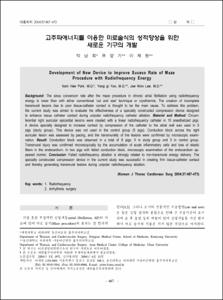KUMEL Repository
1. Journal Papers (연구논문)
1. School of Medicine (의과대학)
Dept. of Thoracic & Cardiovascular Surgery (흉부외과학)
고주파에너지를 이용한 미로술식의 성적향상을 위한 새로운 기구의 개발
- Keimyung Author(s)
- Park, Nam Hee
- Journal Title
- 대한흉부외과학회지
- Issued Date
- 2004
- Volume
- 37
- Issue
- 6
- Keyword
- Radiofrequency; Arrhythmia surgery; 고주파에너지; 부정맥 수술
- Abstract
- Background: The sinus conversion rate after the maze procedure in chronic atrial fibrillation using radiofrequency energy is lower than with either conventional 'cut and saw' technique or cryothermia. The creation of incomplete transmural lesions due to poor tissue-catheter contact is thought to be the main cause. To address this problem, the current study was aimed to evaluate the effectiveness of a specially constructed compression device designed to enhance tissue catheter contact during unipolar radiofrequency catheter ablation. Material and Method: Circumferential right auricular epicardial lesions were created with a linear radiofrequency catheter in 10 anesthetized pigs. A device specially designed to increase contact by compression of the catheter to the atrial wall was used in 5 pigs (study group). This device was not used in the control group (5 pigs). Conduction block across the right auricular lesion was assessed by pacing, and the transmurality of the lesions were confirmed by microscopic examination. Result: Conduction block was observed in a total of 8 pigs; 5 in study group and 3 in control group. Transmural injury was confirmed microscopically by the accumulation of acute inflammatory cells and loss of elastic fibers in the endocardium. In two pigs with failed conduction block, microscopic examination of the endocardium appeared normal. Conclusion: Failed radiofrequency ablation is strongly related to non-transmural energy delivery. The specially constructed compression device in the current study was successful in creating firm tissue-catheter contact and thereby generating transmural lesions during unipolar radiofrequency ablation.
배경: 심방세동의 수술적 치료 방법인 미로술식에 있어 고주파에너지를 이용한 절제술은 전통적인
절개 및 봉합술(cut and saw) 또는 냉동절제술(cyroablation)에 비해 술 후 동율동의로의 전환율이 낮은
것으로 알려져 있다. 이는 절제술 시 심방벽(atrial wall)과 도자 간의 접촉이 원활하지 않아 심방의 전
층에 걸쳐 고주파 에너지가 전달되지 않기 때문인 것으로 생각된다. 이에 고주파 절제시 심방과 도자
간의 접촉을 원활하게 하기 위한 기구를 개발하였으며 동물실험을 통하여 그 임상적인 효과를 관찰
하고자 하였다. 대상 및 방법: 60 kg 내외의 돼지 10마리를 대상으로 하였다. 우심방이 첨부로부터
3∼4 cm 하방의 심방외벽에 고주파에너지를 가하여 우심방이가 우심방에서 완전히 분리되도록 원형
의 병변(circumferential lesions)을 만들었다. 이때 실험군(n=5)에서는 새로 고안한 기구를 이용하여 도
자를 심방벽에 완전히 밀착시킨 후 고주파 에너지를 가하였으며, 대조군(n=5)에서는 이러한 기구의
사용 없이 통상적인 방법으로 에너지를 가하였다. 고주파절제술이 끝난 후 우심방이 첨부에 인공심
장박동 전극을 설치하고 심박동을 유발하여 고주파 절제부위 이하로 심박동이 전달되는지를 관찰하
여 절제술의 성공 여부를 판단하였다. 또한 심방조직에 대해 조직학적 검사를 시행하여 심외막, 심
근, 그리고 심내막층에 고주파에너지에 의한 열손상의 생성 유무를 관찰하였다. 결과: 실험군에서 5
예, 대조군에서 3예 등 총 8예에서 심박동의 전달 차단(conduction block)이 관찰되었으며 조직학적 검
사 소견상 심내막(endocardium)에서 탄성섬유(elastic fiber)의 소실과 급성 염증세포의 축적 등 급성 열
손상의 소견이 관찰되었다. 한편 심박동의 전달 차단이 관찰되지 않았던 대조군의 2예에서는 심내막
이 정상으로 나타났다. 또한 기관 및 식도에 대한 조직학적 검사에서 열손상에 의한 병변은 관찰되지
않았다. 결론: 고주파에너지에 의한 절제술 시 심방의 전층에 병변을 만들기 위해서는 심장과 도자
간의 접촉이 가장 중요한 인자로 생각된다. 본 연구에서 새로 개발한 기구는 고주파에너지를 이용한
도자절제술 시 심장과 도자 간의 확고한 접촉을 유도하여 심방 전층에 병변을 만드는 데 매우 효과
적이었으며 이러한 기구의 사용은 향후 고주파에너지를 이용한 미로술식의 성적향상에 도움이 될 것
으로 사료된다.
- Alternative Title
- Development of New Device to Improve Sucess Rate of Maze Procedure with Radiofrequency Energy
- Keimyung Author(s)(Kor)
- 박남희
- Publisher
- School of Medicine
- Citation
- 박남희 et al. (2004). 고주파에너지를 이용한 미로술식의 성적향상을 위한 새로운 기구의 개발. 대한흉부외과학회지, 37(6), 467–473.
- Type
- Article
- ISSN
- 0301-2859
- Appears in Collections:
- 1. School of Medicine (의과대학) > Dept. of Thoracic & Cardiovascular Surgery (흉부외과학)
- 파일 목록
-
-
Download
 oak-bbb-4225.pdf
기타 데이터 / 697.76 kB / Adobe PDF
oak-bbb-4225.pdf
기타 데이터 / 697.76 kB / Adobe PDF
-
Items in Repository are protected by copyright, with all rights reserved, unless otherwise indicated.